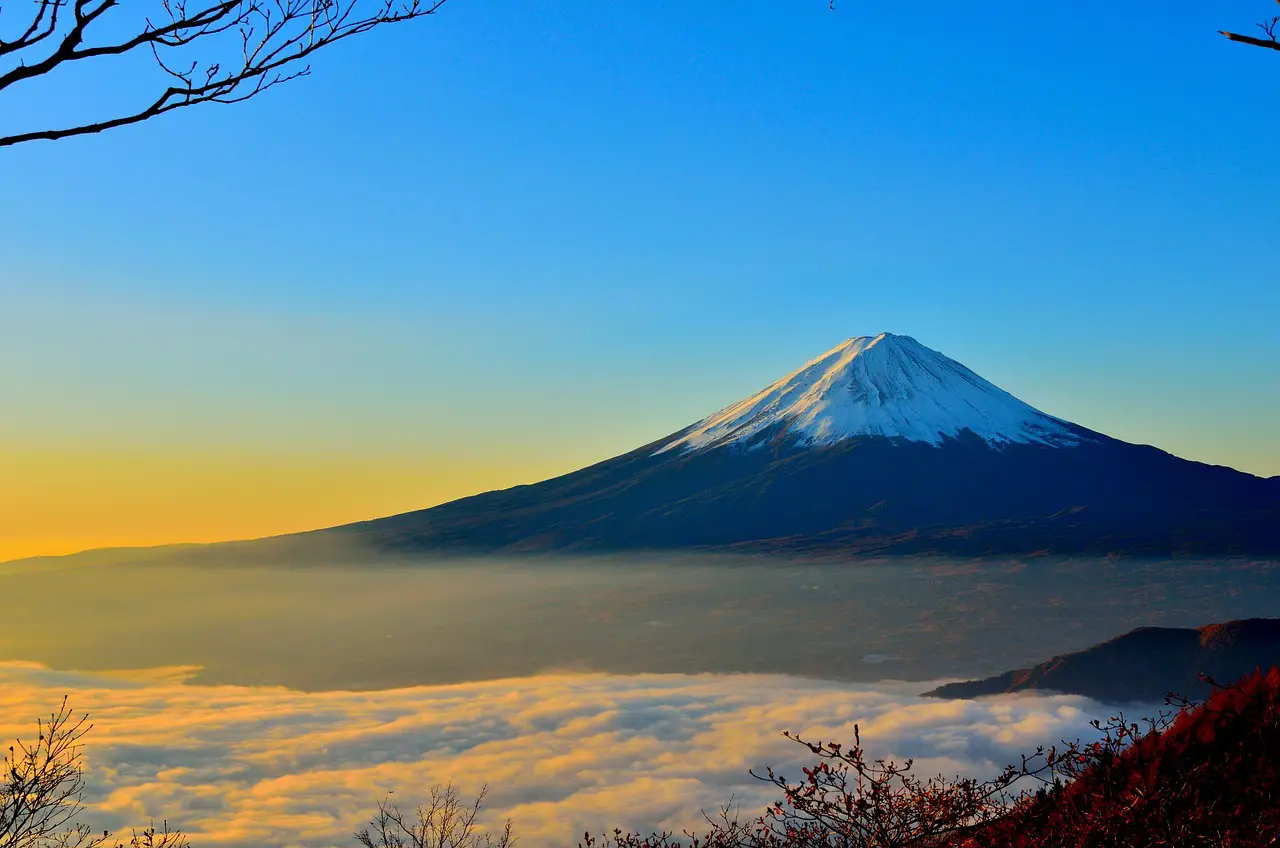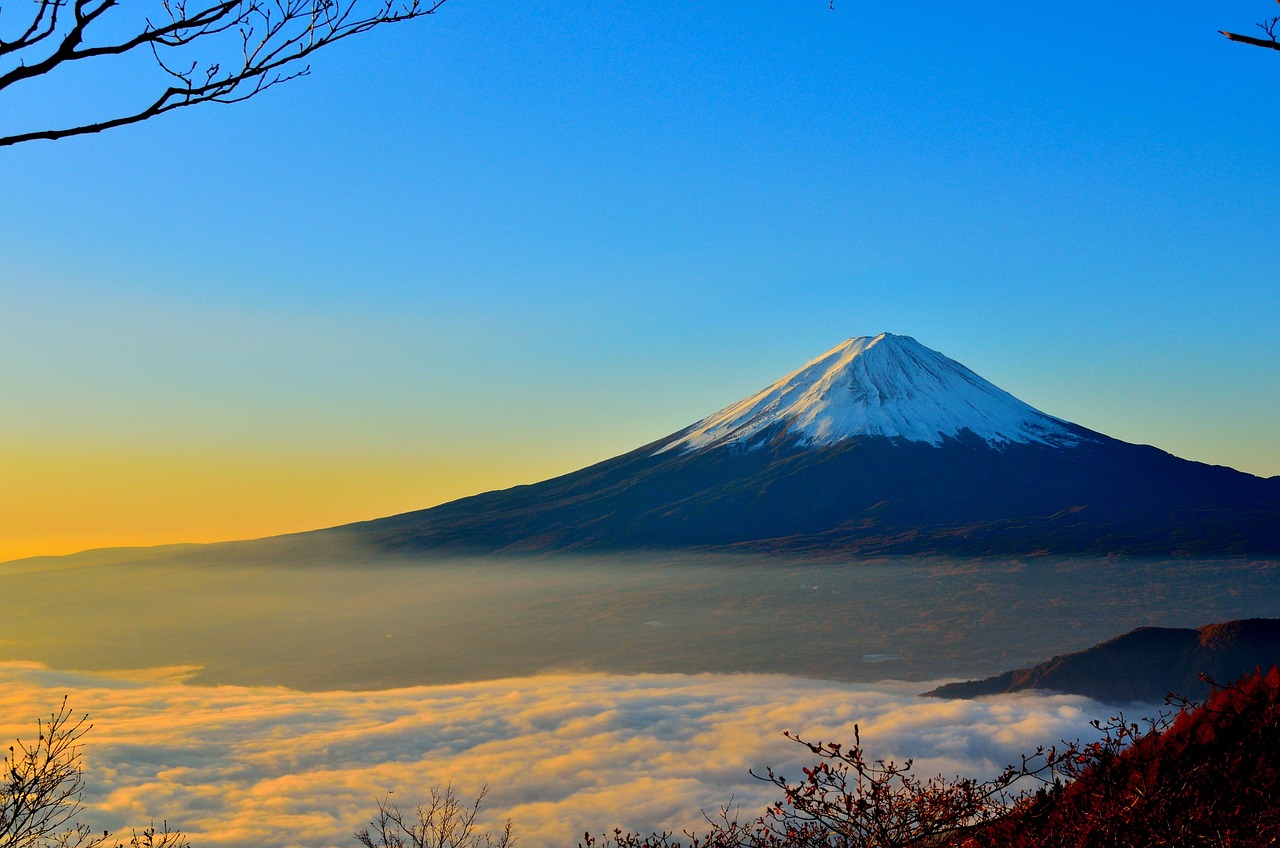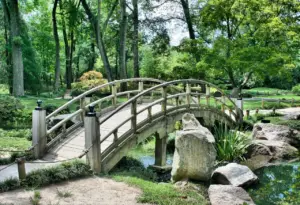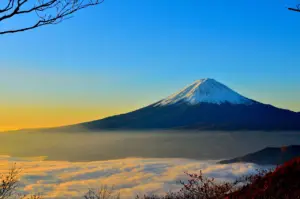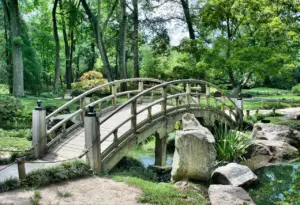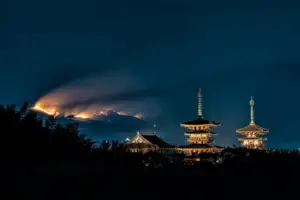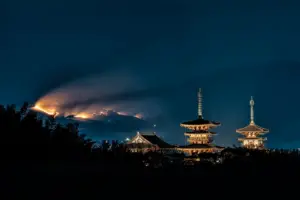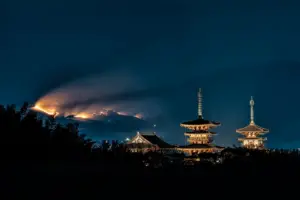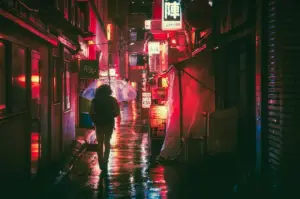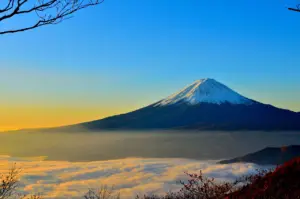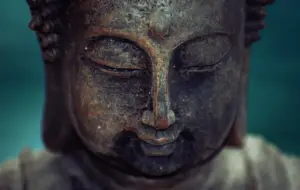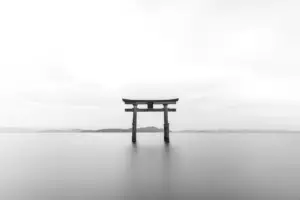Are you looking for a romantic getaway that offers peace and tranquility? Look no further than Japan’s beautiful temples and shrines. These stunning and serene locations offer the perfect escape from the hustle and bustle of daily life and are perfect for couples seeking a little romance.
From the iconic Kinkaku-ji Temple in Kyoto to the peaceful Byodo-in Temple in Uji, Japan is home to some of the most beautiful and romantic temples and shrines in the world. Whether you want to explore the rich history and architecture of these sacred sites or simply relax and enjoy the peaceful surroundings, there is something for everyone.
So why not take a break from the chaos of modern life and discover the beauty and tranquility of Japan’s temples and shrines for yourself?
Key Takeaways
- Japan boasts several stunning temples and shrines that are perfect for those seeking a romantic and tranquil experience.
- Each destination offers unique features and attractions, showcasing Japan’s rich history and architecture.
- Some of the top romantic temples and shrines in Japan include Kinkaku-ji Temple, Itsukushima Shrine, Toshogu Shrine, and Meiji Shrine.
- Visitors can enjoy a variety of activities at these locations, such as hiking, kayaking, and exploring serene gardens and natural wonders.
Kinkaku-ji Temple, Kyoto
If you’re looking for a serene escape, Kinkaku-ji Temple in Kyoto is a must-visit with its stunning golden pavilion and lush surrounding gardens. Also known as the Temple of the Golden Pavilion, this iconic structure is a testament to Japan’s rich cultural heritage.
The temple was originally built in the 14th century as a retirement villa for a shogun, and was later converted into a Zen Buddhist temple. The pavilion’s exterior is covered in gold leaf, creating a breathtaking sight that is reflected in the temple’s pond.
Surrounded by tranquil gardens and a picturesque pond, Kinkaku-ji Temple is the perfect place to find peace and quiet in the midst of bustling Kyoto. The gardens are meticulously maintained and feature a variety of trees and plants that change with the seasons.
Cherry blossoms bloom in the spring, while fiery red maple leaves adorn the trees in the fall. As you wander through the gardens, take a moment to pause and reflect at the many shrines and statues scattered throughout the grounds.
Kinkaku-ji Temple is a true gem of Kyoto and a must-visit for anyone seeking a moment of tranquility.
Itsukushima Shrine, Miyajima
When you visit Itsukushima Shrine in Miyajima, you’ll immediately be struck by the famous Floating Torii Gate.
Take in the sight of this iconic landmark as you explore the island’s natural beauty, including its tranquil forests and stunning views of the sea.
And don’t miss the opportunity to watch the sunset over the water, which is truly a sight to behold.
See the Famous Floating Torii Gate
As you stroll through the tranquil grounds of Miyajima Island, don’t miss the chance to marvel at the iconic Floating Torii Gate. This gate is the symbol of Itsukushima Shrine and is one of the most photographed sights in Japan. The gate appears to float on the water during high tide and is truly a sight to behold.
To fully appreciate the beauty of the Floating Torii Gate, it is important to understand its significance. The torii gate marks the boundary between the sacred and the profane and is considered a gateway to the spirit world. It is believed that passing through the gate cleanses the soul and prepares one for a spiritual experience. So take your time admiring the gate and immerse yourself in the peaceful atmosphere of Miyajima Island.
| Facts About the Floating Torii Gate | |
|---|---|
| Location | Miyajima Island, Hiroshima Prefecture |
| Height | 16.6 meters |
| Material | Camphor Wood |
| Age | Originally built in 1168, current gate built in 1875 |
| Significance | Marks the boundary between the sacred and the profane |
| Fun Fact | The gate appears on the Japanese 10 yen coin |
Explore the Island’s Natural Beauty
Experience the breathtaking beauty of Miyajima Island’s natural wonders. The island is home to a lush forest that covers its mountains, providing a serene and peaceful escape from the busy city.
You can take a hike on one of the many trails that lead through the forest, where you can marvel at the towering trees and the crystal-clear streams that flow through them. The hiking trails also lead to stunning viewpoints that offer panoramic views of the surrounding sea and mountains.
Aside from hiking, Miyajima Island also offers other outdoor activities that allow you to experience its natural beauty up close. You can go kayaking or paddleboarding on the calm waters surrounding the island, or take a boat tour to explore its hidden coves and rocky cliffs.
With its picturesque scenery and tranquil atmosphere, Miyajima Island is the perfect place to unwind and connect with nature. So, take a break from the hustle and bustle of city life and immerse yourself in the island’s stunning natural wonders.
Watch the Sunset over the Sea
You can’t miss the opportunity to watch the stunning sunset over the sea while on Miyajima Island. As the sun sets, the sky turns into a beautiful and vibrant mix of reds, oranges, and pinks, creating a breathtaking view that you won’t forget. The island’s gorgeous beaches and clear blue waters only add to the surreal experience of watching the sunset.
To make the most of your sunset experience, consider visiting one of the island’s many observation points. The table below lists some of the best spots to catch the sunset on Miyajima Island. Keep in mind that the sunset times vary depending on the season, so be sure to check the schedule beforehand. Whether you’re looking for a romantic spot to watch the sunset with a loved one or simply seeking a moment of tranquility, Miyajima Island has plenty of options to offer.
| Observation Point | Location | Best Time to Watch | Views | |||||
|---|---|---|---|---|---|---|---|---|
| Mount Misen | Near the summit | One hour before sunset | Panoramic views of the island and Seto Inland Sea | |||||
| Itsukushima Shrine | On the beach | During low tide | Floating torii gate and sunset over the sea | |||||
| Miyajima Public Beach | On the beach | During high tide | Clear view of the sunset over the sea | |||||
| Daisho-in Temple | On the hill | One hour before sunset | Stunning views of the island and Seto Inland Sea | |||||
| Momijidani Park | In the park | One hour before sunset | Beautiful autumn foliage and sunset over the valley | Aboard a cruise ship | On the deck | During sunset | Panoramic views of the ocean and surrounding islands |
Toshogu Shrine, Nikko
When you visit Toshogu Shrine in Nikko, you’ll be greeted by the intricate and detailed carvings of the sacred buildings and gates. This shrine is dedicated to Tokugawa Ieyasu, the founder of the Tokugawa Shogunate, and is one of the most magnificent shrines in Japan.
As you walk through the complex, you’ll see the Yomeimon Gate, which is adorned with over 500 carvings of animals and gods, and the Five-Story Pagoda, which stands at 36 meters tall and is one of the tallest pagodas in Japan.
The Toshogu Shrine is also known for its beautiful natural surroundings. The shrine is located in a forested area, and visitors will be able to enjoy the tranquil atmosphere as they walk along the paths and admire the architecture.
In autumn, the leaves of the trees turn a vibrant red and orange, making it the perfect time to visit and take in the stunning scenery. If you’re looking for a place to find inner peace and tranquility, the Toshogu Shrine is a must-see destination.
Senso-ji Temple, Tokyo
As you step into the bustling streets of Tokyo, immerse yourself in the rich history and culture of Japan by visiting the Senso-ji Temple. This ancient Buddhist temple, also known as Asakusa Kannon Temple, is located in the heart of Asakusa and is one of the most popular tourist destinations in Tokyo.
As you approach the temple, you’ll be greeted by a vibrant red gate called Kaminarimon, or ‘Thunder Gate,’ which leads you to the temple’s main hall. Inside the temple, you’ll find yourself surrounded by a serene atmosphere, with traditional Japanese architecture and beautiful gardens.
Take a moment to admire the intricate details of the temple’s wooden carvings, paintings, and lanterns. Don’t forget to try some traditional Japanese snacks and souvenirs at the nearby Nakamise shopping street. Whether you’re a history buff, a spiritual seeker, or simply looking for a peaceful escape from the city, the Senso-ji Temple is a must-visit destination in Tokyo.
Fushimi Inari Shrine, Kyoto
If you’re looking for a unique and memorable experience in Kyoto, don’t miss out on exploring the vibrant and mesmerizing Fushimi Inari Shrine. This is a place that is sure to leave a lasting impression, with its striking vermilion gates and winding paths that lead to the summit of Mount Inari.
As one of the most iconic shrines in Japan, Fushimi Inari attracts millions of visitors each year, who come to pay their respects to the god of agriculture and business.
As you make your way through the shrine’s main gate, you’ll be greeted by a sea of bright orange torii gates that stretch out before you. These gates are donated by individuals and companies as a way of expressing their gratitude for success in their endeavors.
As you walk through the gates, you’ll be enveloped in a sense of tranquility and peace, surrounded by the lush greenery of the forest. The climb to the top of Mount Inari is not an easy one, but the views from the summit are well worth the effort.
From here, you can look out over the entire city of Kyoto, and marvel at the beauty of the surrounding landscape.
Byodo-in Temple, Uji
You’ll love exploring the Byodo-in Temple in Uji, where you can admire the stunning architecture and serene gardens. This temple is a UNESCO World Heritage Site and is known for its iconic Phoenix Hall, which features a beautiful statue of the Amitabha Buddha.
The temple was built in 998 AD and is one of the oldest wooden structures in Japan, making it a must-visit destination for architecture enthusiasts.
Aside from the impressive architecture, the temple’s gardens are also a sight to behold. Take a stroll through the lush greenery and enjoy the peaceful atmosphere as you take in the beauty of the surrounding nature.
Here are three things to keep in mind when visiting the Byodo-in Temple:
-
Don’t forget to take a photo in front of the Phoenix Hall, which is surrounded by a pond and is especially stunning during cherry blossom season.
-
Check out the museum located on site, which displays various artifacts and exhibits related to the temple’s history and significance.
-
Take a moment to appreciate the intricate details of the temple’s interior, such as the painted ceiling and ornate carvings. It’s truly a work of art that you won’t want to miss.
Meiji Shrine, Tokyo
When you’re in Tokyo, don’t miss the chance to visit Meiji Shrine, a beautiful and peaceful oasis in the heart of the city. This shrine is dedicated to Emperor Meiji and his wife, Empress Shoken, who were instrumental in modernizing Japan in the late 19th century.
As you approach the shrine, you’ll be amazed by the towering, centuries-old trees that line the path. The tranquil atmosphere will envelop you, and you’ll feel your stress melting away. Once you reach the shrine, you’ll be struck by the grandeur of the entrance gate, which stands over 40 feet tall.
As you continue along the path, you’ll see the main shrine building, which is made of cypress wood and copper. The intricate carvings and decorations on the building are stunning, and you’ll feel a sense of awe as you take it all in. The shrine is surrounded by a beautiful forest, which is home to over 100,000 trees donated from all over Japan.
Meiji Shrine is a must-visit destination for anyone seeking tranquility in Tokyo.
Himeji Castle, Hyogo
Located in Hyogo, Himeji Castle is a stunning example of Japanese feudal architecture. This historic castle is also known as the White Heron Castle due to its white exterior and resemblance to a bird in flight. The castle dates back to the 17th century and is considered one of the most beautiful and well-preserved castles in Japan.
The castle is surrounded by a moat and features multiple buildings and courtyards within the complex. Visitors can explore the castle’s interior, which includes steep staircases, secret passages, and impressive views of the surrounding city.
The castle is especially beautiful during the cherry blossom season when the trees surrounding the castle bloom in pink flowers. If you’re looking for a serene and beautiful location to unwind and appreciate Japan’s history and architecture, Himeji Castle is a must-visit destination.
Frequently Asked Questions
What is the history behind the construction of Kinkaku-ji Temple?
The Kinkaku-ji Temple, also known as the Temple of the Golden Pavilion, is a popular attraction in Kyoto, Japan.
The temple was originally built in 1397 as a retirement villa for the shogun Ashikaga Yoshimitsu.
After his death, the villa was converted into a Zen temple by his son, and it has since undergone several renovations and restorations.
The most recent restoration was completed in 1955 after the temple was burned down by a monk in 1950.
The temple’s famous golden exterior is made of real gold leaf and represents the extravagant wealth of the shogun.
Today, the Kinkaku-ji Temple is a designated UNESCO World Heritage Site and a must-see for anyone visiting Kyoto.
How long does it take to reach Itsukushima Shrine from Miyajima Island?
To reach Itsukushima Shrine from Miyajima Island, it will only take you around 10 minutes by foot.
The shrine is located on the island’s western coast and can be accessed via a short walk across the shallow waters during low tide.
However, during high tide, the shrine appears to be floating on water, making it a popular spot for tourists to take photos.
Itsukushima Shrine is known for its iconic floating torii gate, which is considered one of Japan’s three most beautiful sights.
The shrine’s serene atmosphere and stunning scenery make it a must-visit destination for those who are seeking tranquility in Japan.
What is the significance of the three monkeys at Toshogu Shrine?
The three monkeys at Toshogu Shrine hold significant importance in Japanese culture. These monkeys are known as ‘See no Evil, Hear no Evil, Speak no Evil’ and represent the principle of not engaging in evil deeds. The monkeys are depicted covering their eyes, ears, and mouth with their hands, respectively.
According to legend, these monkeys were inspired by a Chinese Confucian philosopher, who believed that by not seeing, hearing, or speaking evil, one could lead a virtuous life.
The Toshogu Shrine is one of the most important Shinto shrines in Japan and is located in Nikko, a city known for its scenic beauty and historical significance. The shrine is a popular tourist destination and is recognized for its intricately designed wooden architecture and ornate decorations.
Are there any special rituals or customs visitors should know about before visiting Senso-ji Temple?
Before visiting Senso-ji Temple, there are a few customs and rituals that visitors should know about.
First, it’s customary to purify oneself before entering the temple by washing your hands and rinsing your mouth at the purification fountain.
Next, visitors should bow twice, clap their hands twice, and then bow once more in front of the main hall. This is done to show respect and gratitude to the gods.
Visitors can also purchase omamori, or amulets, for good luck and protection.
Finally, it’s important to remember that photography isn’t allowed inside the temple.
By following these customs and rituals, visitors can fully appreciate the beauty and spiritual significance of Senso-ji Temple.
What is the best time of day to visit Fushimi Inari Shrine to avoid crowds?
If you want to avoid crowds when visiting Fushimi Inari Shrine, the best time to go is early in the morning before the crowds start to arrive. The shrine opens at 6:30 am, so arriving around that time will give you a chance to experience the tranquility of the shrine without all the noise and crowds.
Another option is to visit the shrine in the evening since it’s open until 5 pm, and most visitors tend to leave around 4 pm. This will give you a chance to explore the shrine in a peaceful setting. However, keep in mind that the shrine is lit up at night, creating a beautiful and unique atmosphere.
Overall, the best time to visit Fushimi Inari Shrine is early in the morning or in the evening to avoid crowds and enjoy the serene beauty of this incredible site.
Conclusion
Congratulations, you’ve just discovered some of the most romantic temples and shrines in Japan! Exploring these sacred places can be a truly tranquil experience, and they offer a glimpse into the country’s rich cultural heritage.
From the stunning Kinkaku-ji Temple in Kyoto to the iconic Fushimi Inari Shrine, each of these sites has a unique charm that is sure to leave you in awe. As you wander through the peaceful gardens and marvel at the intricate architecture, you’ll feel a sense of calm wash over you.
The Itsukushima Shrine in Miyajima, for example, is particularly mesmerizing when the tide is high and the floating torii gate is reflected in the water. Meanwhile, the Toshogu Shrine in Nikko is known for its elaborate carvings and colorful decorations, which are truly a feast for the eyes.
Whether you’re a history buff, a nature lover, or simply seeking some quiet time away from the hustle and bustle of the city, these romantic temples and shrines in Japan offer something for everyone. So why not take a break from your busy schedule and immerse yourself in the beauty and serenity of these sacred places? You won’t regret it.


